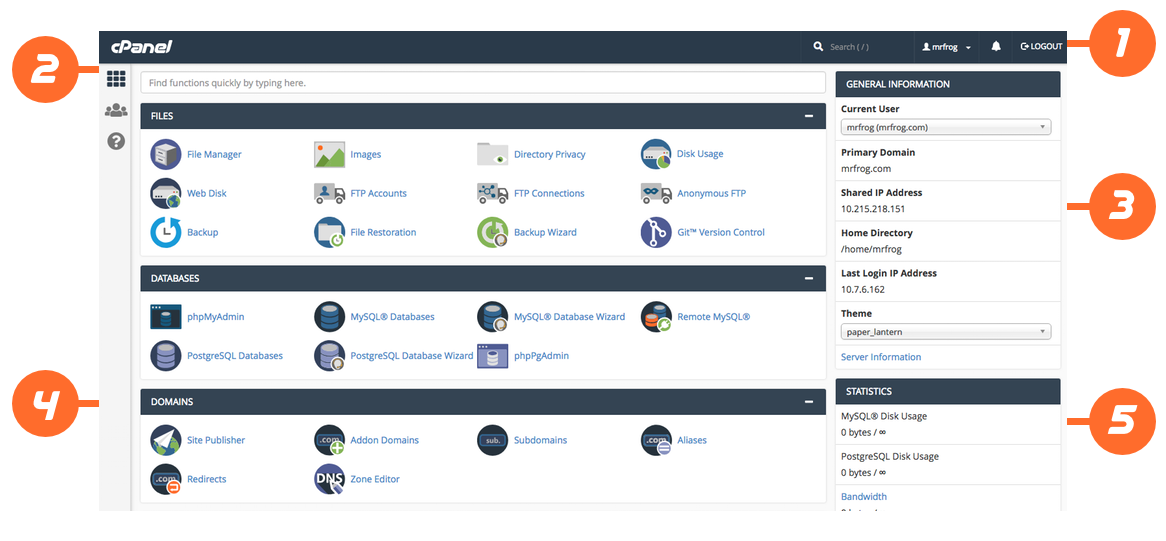Overview
The cPanel interface is the hub of your cPanel user account and provides you with access to important information and updates.

The cPanel interface consists of the following sections:
- Your hosting provider’s server profile may disable certain features in the cPanel interface. For more information, read our How to Use Server Profiles documentation.
- If your server administrator has enabled cPanel Analytics at the server level, a graph icon (
 ) will appear on the right side of the interface.
) will appear on the right side of the interface.- Click the icon to display your account-level cPanel Analytics settings. Select Allow Data Collection to enable cPanel Analytics for your account, or select Deny Data Collection to disable it.
- cPanel, L.L.C. values your privacy. For more information about how we collect and use cPanel Analytics data, read our cPanel Analytics documentation.
Navigation bar
Every interface in cPanel displays the navigation bar. The navigation bar provides the currently-active account information, controls that allow you to change settings, and a link to log out of your account.
- Click the site logo to navigate to the Home interface.
- Use the Search Features text box to quickly find the interfaces that you need.
/) keyboard shortcut to quickly access the Search Features text box.
- Click your username to manage your preferences and configure the cPanel interface.
- Click the Notifications icon (
 ) to display any messages, warnings, and errors on your cPanel account. Server owners can also customize this interface to broadcast important information to their customers.
) to display any messages, warnings, and errors on your cPanel account. Server owners can also customize this interface to broadcast important information to their customers.
Sidebar
Every interface in cPanel displays the sidebar. The sidebar provides access to the following features:
- Click the Home icon (
 ) to return to the cPanel Home interface. This section provides access to all of cPanel’s features. If you are a reseller, you can customize the content to suit your needs.
) to return to the cPanel Home interface. This section provides access to all of cPanel’s features. If you are a reseller, you can customize the content to suit your needs. - Click the User Manager icon (
 ) to navigate to the User Manager interface (cPanel >> Home >> Preferences >> User Manager).
) to navigate to the User Manager interface (cPanel >> Home >> Preferences >> User Manager).
General Information
The General Information section displays the following information about your cPanel account:
Current User
The name of the current cPanel account. If your account can access multiple cPanel accounts and your hosting provider enables the Theme Switching feature in WHM’s Feature Manager interface (WHM >> Home >> Packages >> Feature Manager), you can use the menu to search for and switch between accounts.
Primary Domain
The current account’s primary or main domain name. Click the wrench (![]() ) icon to navigate to cPanel’s SSL/TLS Status interface (cPanel >> Home >> Security >> SSL/TLS Status). This icon only appears if a problem exists with the status of the certificate. This section also displays the type of certificate that secures the primary domain:
) icon to navigate to cPanel’s SSL/TLS Status interface (cPanel >> Home >> Security >> SSL/TLS Status). This icon only appears if a problem exists with the status of the certificate. This section also displays the type of certificate that secures the primary domain:
- DV Certificate — A domain-validated certificate.
- EV Certificate — An extended-validation certificate.
- OV Certificate — An organization-validated certificate.
- Self-signed Certificate — A self-signed certificate.
- No Valid Certificate — A valid certificate exists, but it does not currently secure the domain. For example, an expired or revoked certificate.
Shared IP Address or Dedicated IP Address
The current account’s shared or dedicated IP address:
- A shared IP address means that multiple websites within one server use a single IP address.
- A dedicated IP address means that the website possesses its own IP address.
Home Directory
The absolute path to the account’s /home directory on the server.
Last Login IP Address
The IP address of the user that most recently logged in to the account.
10.1.1.1 IP address, and then log in multiple times via the 10.2.2.2 IP address, the interface will display 10.1.1.1 as the Last Login IP address value. It will not display 10.2.2.2 as the Last Login IP address value until you log in through a different IP address.
Theme
The current cPanel theme. If your account includes more than one theme, you can use the menu to search for and switch between cPanel themes.
Server Information
Click this link to navigate to cPanel’s Server Information interface (cPanel >> Home >> Server Information), which displays additional information about the account and its server.
Features
The cPanel interface lists of all of your account’s available features in groups for different types of functionality. To search for a desired feature, use the Find functions quickly by typing here text box.
Statistics
The Statistics section displays important usage statistics for your cPanel account. This section uses colors and symbols to display information about your cPanel account’s resource usage.
Yellow background
Statistics will display a yellow background if they meet either of the following criteria:
- Your server cannot retrieve information about the item’s usage or quota.
- Your account uses 60% or more of an item’s quota.
Red background
Statistics will displays a red background if your account uses 80% or more of an item’s quota. These items appear at the beginning of the Statistics section.
Symbols
Each statistic may display one of the following symbols:
- An infinity symbol (
∞) — This icon indicates an unlimited quota. Otherwise, the interface displays your account’s quota limits. - A plus (
+) icon — Click this icon to increase the quota for this statistic in your hosting plan. This symbol appears if your hosting provider has added integration links to your server. - A wrench (
 ) icon — Click this icon to access the relevant cPanel interface where you can reduce your quota usage. For example, if your Email Accounts statistic is high, you can delete unused email accounts in cPanel’s Email Accounts interface (cPanel >> Home >> Email >> Email Accounts). This symbol appears if your hosting provider has not added integration links to your server.
) icon — Click this icon to access the relevant cPanel interface where you can reduce your quota usage. For example, if your Email Accounts statistic is high, you can delete unused email accounts in cPanel’s Email Accounts interface (cPanel >> Home >> Email >> Email Accounts). This symbol appears if your hosting provider has not added integration links to your server. - An exclamation mark (
!) icon — Hover your cursor over this symbol to read more information about the error. This symbol appears if your server cannot retrieve more information about the usage or quota limit for your server.
Bandwidth
The Bandwidth statistic displays the amount of inbound and outbound data, in megabytes (MB), that your account transferred for the current month.
Disk Usage
The Disk Usage statistic displays the amount of disk space, in megabytes (MB), that your account currently uses.
File Usage
The File Usage statistic displays the number of files and directories (inodes) that your account currently uses.
- You will only see this statistic if your hosting provider enables it.
- The interface will display this statistic as Local File Usage for a distributed cPanel account. This is the account’s current local server current usage. It does not include the file usage from the child node.
MySQL® Disk Usage
The MySQL Disk Usage statistic displays the amount of disk space, in bytes, that your account’s MySQL or MariaDB® databases currently use.
PostgreSQL Disk Usage
The PostgreSQL Disk Usage statistic displays the amount of disk space, in bytes, that your account’s PostgreSQL® databases currently use.
Mailing Lists Disk Usage
The Mailing Lists Disk Usage statistic displays the amount of disk space, in bytes, that your account’s Mailman mailing lists currently use.
Addon Domains
The Addon Domains statistic displays the number of addon domains that your account currently uses.
Subdomains
The Subdomains statistic displays the number of subdomains that your account currently uses.
Aliases
The Aliases statistic displays the number of aliases (parked domains) that your account currently uses.
Email Accounts
The Email Accounts statistic displays the number of email accounts that your account currently uses.
Mailing Lists
The Mailing Lists statistic displays the number of Mailman mailing lists that your account currently uses.
Autoresponders
The Autoresponders statistic displays the number of autoresponders that your account currently uses.
Forwarders
The Forwarders statistic displays the number of forwarders that your account currently uses.
Email Filters
The Email Filters statistic displays the number of email filters that your account currently uses.
FTP Accounts
The FTP Accounts statistic displays the number of FTP accounts that your account currently uses.
MySQL Databases
The MySQL Databases statistic displays the number of MySQL or MariaDB databases that your account currently uses.
PostgreSQL Databases
The PostgreSQL Databases statistic displays the number of PostgreSQL databases that your account currently uses.
CPU Usage
The CPU Usage statistic displays the amount of CPU that your account currently uses.
Memory Usage
The Memory Usage statistic displays the amount of memory that your account currently uses.
Entry Processes
The Entry Processes statistic displays the number of entry processes that your account currently uses.
Custom Statistics
Third-party developers can create a module that displays custom statistics. For more information, read our Guide to cPanel Plugins – Pluggable Statistics Modules documentation.




